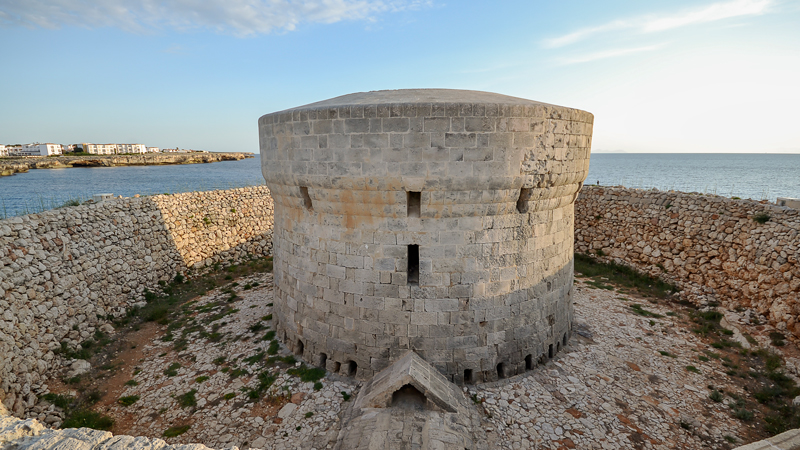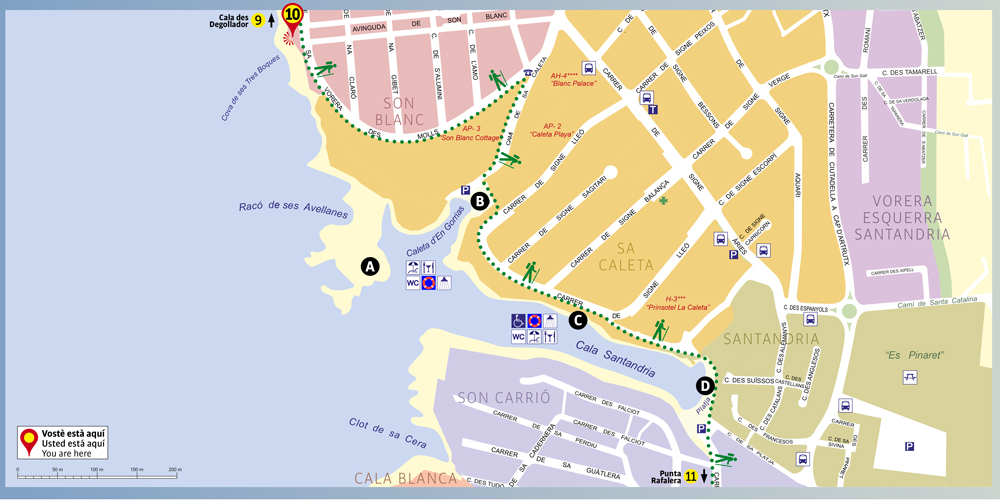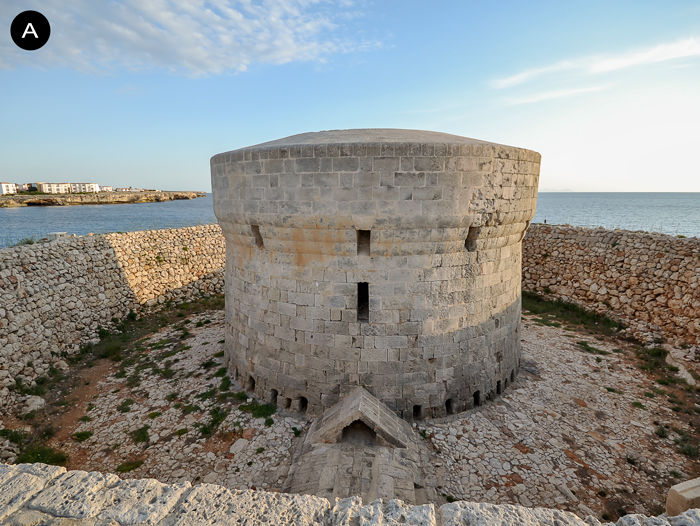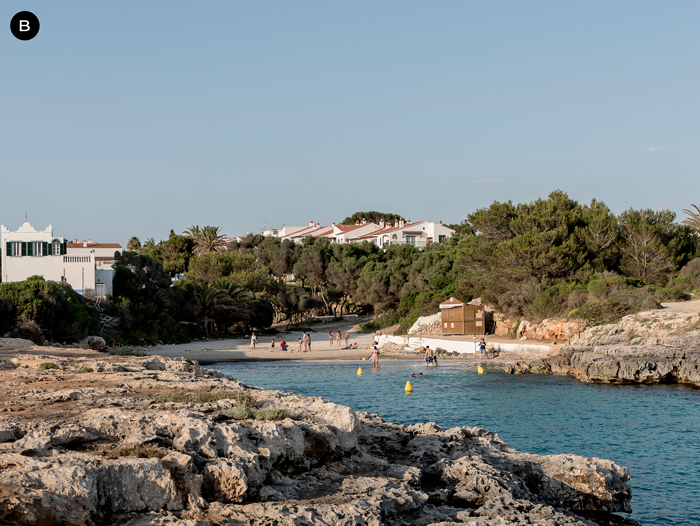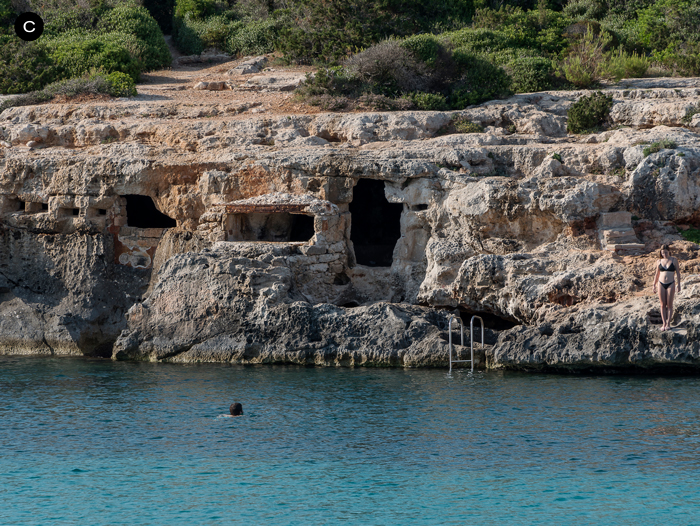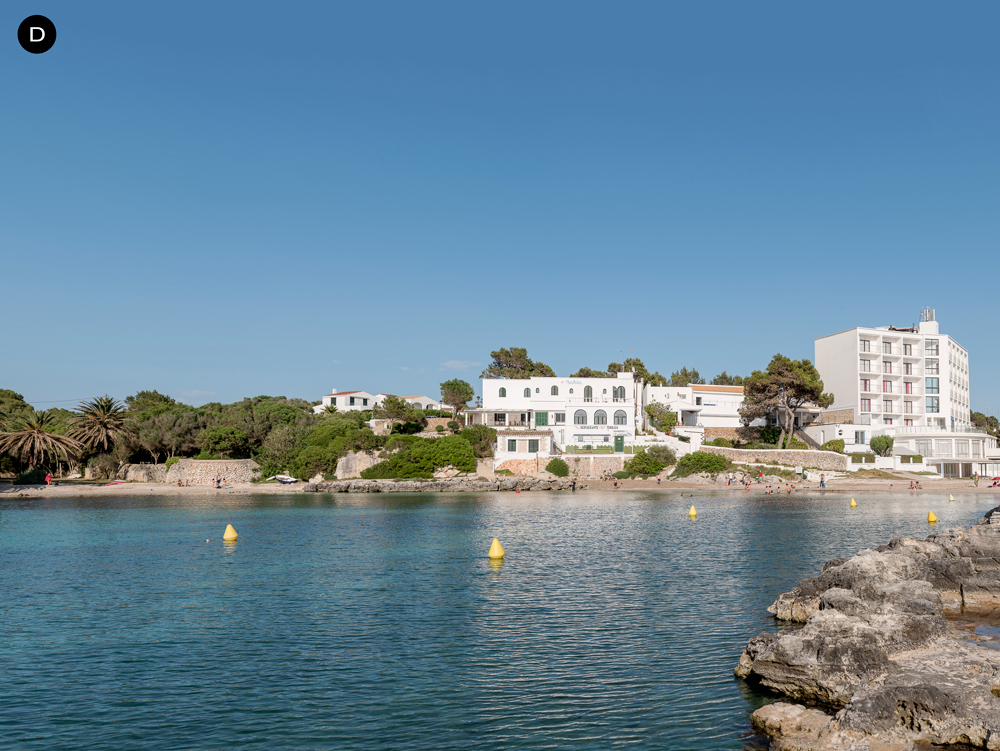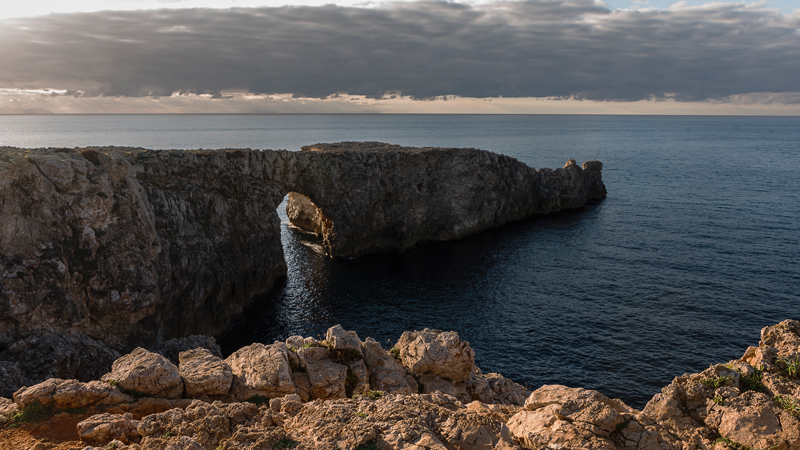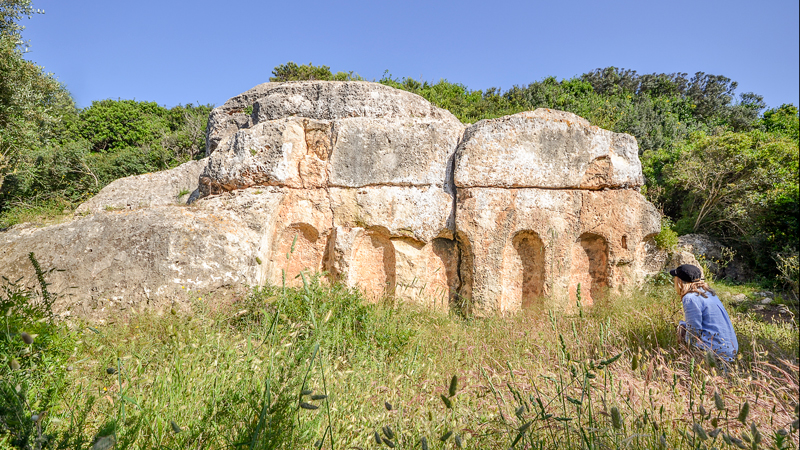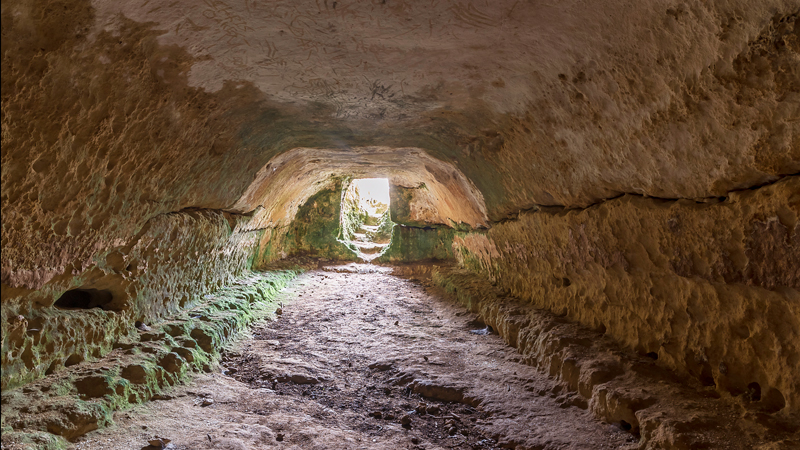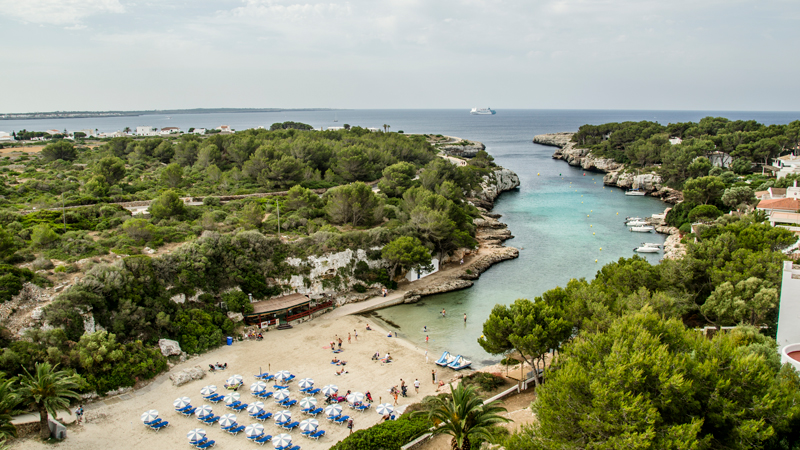Sa Cova de ses Tres Boques
A. ES CASTELLAR DE SA CALETA (O TORRE DE SANTANDRIA)
Torre de defensa costanera construïda l’any 1799, durant la darrera dominació britànica de l’illa (1798-1802). Les torres britàniques de Menorca tenien com a objectiu impedir el fondeig de les esquadres enemigues que hi pretenguessin de
sembarcar per assetjar i rendir l’illa. Havien d’allotjar una petita guarnició militar i resistir l’atac dels canons enemics. L’interès d’aquesta torre rau en el fet que és una de les més innovadores de l’enginyeria militar britànica de l’època a l’illa,
i un exemple de com les noves idees de defensa s’anaven implantant davant l’aparició d’un armament cada cop més potent.
És, juntament amb la resta de torres britàniques costaneres de l’illa, el testimoni que Menorca serví de terreny de proves per al programa britànic de defensa del segle xix.
B. SACALETA D’EN GORRIES
Caleta dominada per la torre de defensa construïda en temps del general Charles Stuart, governador de Menorca entre 1798 i 1800. És una petita cala precedida per una zona verda que disposa de tots els serveis. La seva proximitat a la ciutat, l’accés fàcil, la tranquil·litat i la transparència de les seves aigües l’han convertida, molt abans del boom turístic iniciat en la dècada de 1960, en un lloc molt popular entre els ciutadellencs per nadar i refrescar-se els calorosos dies d’estiu. Mal
grat la presència d’algunes petites casetes d’esbarjo vora la mar, la caleta no patí la pressió urbanística fins ben entrada la dècada de 1970. Des de llavors, s’han anat configurant als voltants les urbanitzacions turístiques i residencials de Son
Blanc i Sa Caleta.
C. PATRIMONI ARQUEOLÒGIC I MILITAR A SANTANDRIA
La cala de Santandria té una costa de baixa alçada i amb poca vegetació. Si ho miram amb atenció, veurem algunes co vetes picades a la roca. Són, curiosament, hipogeus prehistòrics que els pobladors de l’illa de fa més de dos mil anys uti
litzaren com a tombes col·lectives. Les cavitats a la roca que hi ha davant la parada de bus també formen part d’aquesta necròpolis. Alguns d’elles es reconvertiren en trinxeres o en niu de metralladores durant la Guerra Civil espanyola. Cal
recordar que Menorca es mantingué fidel a la República fins a l’ocupació del bàndol nacional el febrer de 1939, i durant els anys que durà la guerra la defensa de la costa fou una prioritat. L’aprofitament dels recursos existents, en aquest cas
unes tombes posttalaiòtiques, ocultava la presència d’aquestes posicions.
D. CALA DE SANTANDRIA
Com a conseqüència de la guerra dels Set Anys entre França i Gran Bretanya, el 1756 una esquadra francesa comandada pel duc de Richelieu arribà a Santandria per conquerir Menorca, aleshores sota domini britànic. Des d’aquí ocupà tota
l’illa i posà setge al castell de Sant Felip de Maó, que es rendí poc després. L’ocupació francesa de Menorca durà fins al 1763. No és d’estranyar, doncs, que amb el retorn de l’illa a la sobirania britànica es construís a la bocana d’aquesta res
guardada cala un torre de defensa. Ha estat una de les cales més freqüentades i estimades pels ciutadellencs. I aquí es va construir el primer hotel turístic de Ciutadella: Ses Voltes. La cala disposa de tots els serveis d’estiu, està adaptada i s’hi
pot accedir amb transport públic tot l’any
A. ES CASTELLAR DE SA CALETA (OR TORRE DE SANTANDRIA)
A coastal defence tower built in 1799, during the last period of British control of the island (1798–1802). The British towers in Menorca had the purpose of stopping enemy forces that intended to come ashore, lay siege to the island and seize control of it from anchoring. They were intended to house a small military garrison and withstand attack by enemy cannons.
This tower is of particular interest because it is one of the most innovative examples of British military engineering from this period on the island, and it is an example of how new defensive ideas were implemented when faced with the appearance of ever more powerful armament. Along with the other British coastal towers on the island, it is evidence of how Menorca served as a testing ground for the British defensive programme of the nineteenth century.
B SA CALETA D’EN GORRIES
A small cove dominated by the defensive tower built in the time of General Charles Stuart, governor of Menorca between 1798 and 1800. This is a small cove with a green space before it, which has all facilities. Its proximity to the city, easy access and the tranquillity and transparency of its waters meant that long before the tourism boom that started in the 1960s it was a very popular place among the people of Ciutadella for bathing and cooling off on hot summer days. Despite the presence of some old holiday houses overlooking the sea, the cove was not affected by the pressure to develop until the 1970s. Since then, the tourist and residential developments of Son Blanc and Sa Caleta have grown around it.
C.ARCHAEOLOGICAL AND MILITARY HERITAGE IN CALA SANTANDRIA
Cala Santandria has a low-lying coast with little vegetation. If you look carefully, you will see some small caves dug out of the rock. These are prehistoric hypogaea that the inhabitants of the island used as collective tombs over two thousand years ago. The cavities in the rock opposite the bus stop are also part of this necropolis. Some of them were turned into trenches or machine gun nests during the Spanish Civil War. It is worth noting that Menorca remained loyal to the Republic until its occupation by Franco’s forces in February 1939, and defending the coast was a priority throughout the war. By using existing resources, in this case post-Talaiotic tombs, the presence of these positions was hidden.
D. CALA SANTANDRIA
As part of the Seven Years War between France and Great Britain, a French squadron commanded by the Duke of Richelieu came to Santandria in 1756 to conquer Menorca, which at that moment was under British control. From here it occupied
the whole island, laying siege to the castle of San Felipe in Maó, which surrendered shortly after. The French occupation of Menorca lasted until 1763. It is no surprise then that the with the return of British sovereignty to the island, a defensive tower was built at the mouth of this sheltered cove. It is one of the people of Ciutadella’s most frequented and best loved coves. It was also the spot chosen to build Ciutadella’s first hotel for tourists, Ses Voltes. In the summer, the cove has all facilities. It is accessible and you can get there by public transport all-year round.
